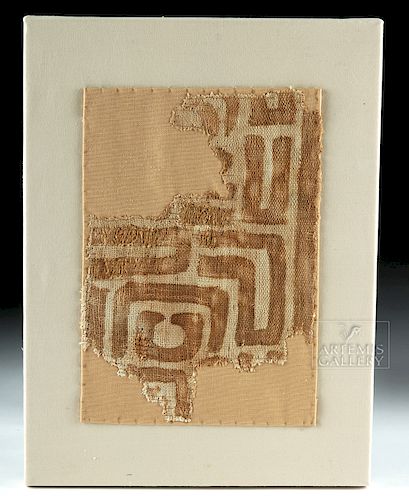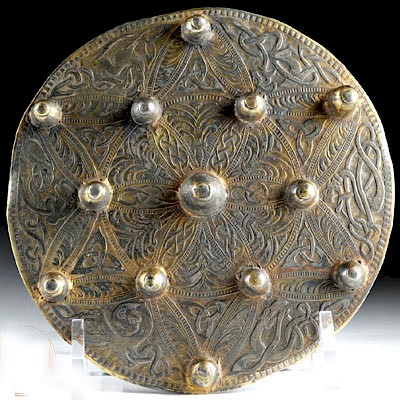Unique Chavin - Karwar Textile Fragment
Lot 87b
About Seller
Artemis Fine Arts
686 S Taylor Ave, Ste 106
Louisville, CO 80027
United States
Selling antiquities, ancient and ethnographic art online since 1993, Artemis Gallery specializes in Classical Antiquities (Egyptian, Greek, Roman, Near Eastern), Asian, Pre-Columbian, African / Tribal / Oceanographic art. Our extensive inventory includes pottery, stone, metal, wood, glass and textil...Read more
Estimate:
$800 - $1,200
Absentee vs Live bid
Two ways to bid:
- Leave a max absentee bid and the platform will bid on your behalf up to your maximum bid during the live auction.
- Bid live during the auction and your bids will be submitted real-time to the auctioneer.
Bid Increments
| Price | Bid Increment |
|---|---|
| $0 | $25 |
| $300 | $50 |
| $1,000 | $100 |
| $2,000 | $250 |
| $5,000 | $500 |
| $10,000 | $1,000 |
| $20,000 | $2,500 |
| $50,000 | $5,000 |
| $100,000 | $10,000 |
| $200,000 | $20,000 |
About Auction
By Artemis Fine Arts
Jul 19, 2018
Set Reminder
2018-07-19 10:00:00
2018-07-19 10:00:00
America/New_York
Bidsquare
Bidsquare : Fine Antiquities/Ethnographic Art
https://www.bidsquare.com/auctions/artemis-gallery/fine-antiquities-ethnographic-art-3329
Featuring classical antiquities, ancient and ethnographic art from cultures encompassing the globe, plus fine art. Artemis Fine Arts info@artemisgallery.com
Featuring classical antiquities, ancient and ethnographic art from cultures encompassing the globe, plus fine art. Artemis Fine Arts info@artemisgallery.com
- Lot Description
Pre-Columbian, South Coast Peru, Chavin-Karwar, ca. 4th to 3rd century BCE. A cotton based textile fragment from the North Coast of Peru, but purportedly found in South Coast Peru. The tightly woven fabric is decorated with curvilinear and linear motifs of refined iron-rich pigments. As a wearable and portable artform in which complex imagery was featured, textiles spread Chavin iconography from the northern coast, where it originated, to the south, where this fragment was purportedly found. Even more fascinating, the painting style and visual motifs resemble those of stone carvings at Chavin de Huantar. Size: 8.625" W x 6" H (21.9 cm x 15.2 cm); 11.875" W x 8.875" H (30.2 cm x 22.5 cm) with fabric covered mount.
Andean textile art began as early as the third millennium BCE and continued to be a medium of artistic expression as well as a medium used for communicating religious, social, and political information for millennia. Interestingly, in Peru fabric art preceded ceramics by more than a thousand years. Sometimes designs were woven into the fabric, sometimes they were embroidered, and sometimes, as we see in this example, they were painted onto the fabric.
Provenance: private Hawaii, USA collection; ex-Arte Textile Gallery, San Francisco, California, USA
All items legal to buy/sell under U.S. Statute covering cultural patrimony Code 2600, CHAPTER 14, and are guaranteed to be as described or your money back.
A Certificate of Authenticity will accompany all winning bids.
We ship worldwide and handle all shipping in-house for your convenience.
#136625Fragment shows normal wear, areas of loose fibers, and fading to pigment, commensurate with age. There are two small areas of repair. An ancient fragment mounted on newer tawny beige fabric panel and lighter beige fabric covered mount.Condition
- Shipping Info
-
All shipping is handled in-house for your convenience. Your invoice from Artemis Gallery will include shipping calculation instructions. If in doubt, please inquire BEFORE bidding for estimated shipping costs for individual items.
-
- Buyer's Premium



 EUR
EUR CAD
CAD AUD
AUD GBP
GBP MXN
MXN HKD
HKD CNY
CNY MYR
MYR SEK
SEK SGD
SGD CHF
CHF THB
THB














